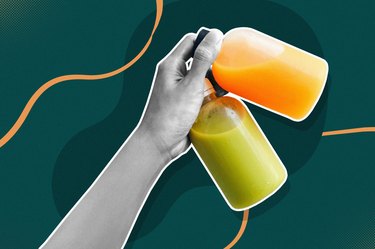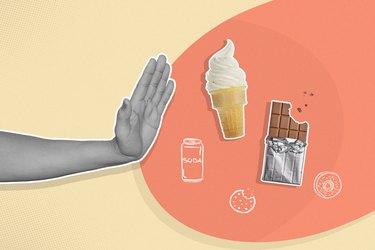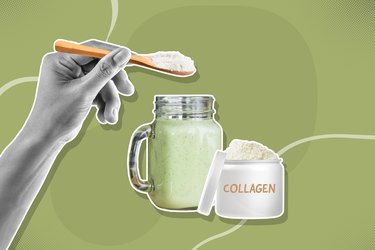
Many of today's diets are designed to fill you up on protein and fat. Carbs and sugar are often vilified, and fiber is much forgotten.
But skipping fiber means your body is missing out on a wealth of health benefits.
Video of the Day
Video of the Day
"The fiber you get from whole foods, fruits and vegetables also contain vitamins, minerals and antioxidants, and therefore, promote health and wellbeing," says Amy Shapiro, RD, CDN, founder of Real Nutrition.
The Different Types of Fiber
There are two different types of fiber in whole foods — soluble and insoluble fiber — and both have different benefits.
Soluble fiber soaks up water and turns into a gel-like substance during digestion, which slows things down and helps keep your blood sugar stabilized. Insoluble fiber adds bulk to your stool and makes it easier for food to pass through the stomach and intestines, according to the U.S. National Library of Medicine.
It's important to note that the fiber you get from processed foods is different and doesn't provide the same kind of benefits.
"Processed foods that don't naturally contain fiber have processed fiber added. The food industry often refers to this as 'isolated fiber,'" explain Lyssie and Tammy Lakatos, RDN, CFT, founders of the Nutrition Twins and creators of the 21-Day Body Reboot program.
These isolated fibers can make you feel full and promote regularity, but they don't offer the phytonutrients, antioxidants and anti-inflammatory compounds that you'll find in fruits, vegetables, whole grains and pulses, the Lakatos twins say. "Processed fiber originally comes from foods like chicory root, corn and sugar cane, and then is added into foods like snack bars, pasta, bread and sugary cereals."
"Real foods that are naturally rich in fiber also come packaged with phytonutrients and antioxidants that benefit your health in other ways, but these benefits don't exist when isolated fiber is added to processed foods," the Lakatos twins say.
In fact, certain functional isolated fibers in processed foods, particularly those that are non-viscous like inulin, fructooligosaccharides and wheat dextrin, don't lower bad LDL cholesterol and improve glycemic control compared to fibers from whole foods, per a November 2016 review in the Journal of the Academy of Nutrition and Dietetics.
So when it comes to choosing foods with fiber, make sure to go whole — not packaged. The problem is most people fail to get enough fiber in their diets. More than 90 percent of American adults and children fall short of getting the recommended daily fiber intake, according to a May 2012 study in The Journal of Nutrition.
Effects of Not Getting Enough Fiber
The American diet is full of processed foods and simple carbs, like french fries, hamburger buns, potato chips — and people limit their plant intake either due to inaccessibility or dislike. This can lead to low fiber intake, Shapiro explains.
"Whole foods can also be intimidating and expensive and can take time to prepare. To many, this is another job to add to their list."
Here's a look at what can happen when you don't get enough fiber in your diet.
Your Digestion Might Take a Hit
If you're straining to poop, it might be a sign that you simply aren't getting enough fiber in your diet.
Not eating enough high-fiber foods can cause constipation, which happens when your poops become, um, too difficult to pass, or you're having fewer than three bowel movements a week, according to the Cleveland Clinic. Although, how often you should poop varies per person.
To ensure you're eating the recommended amount of fiber, the 2015-2020 Dietary Guidelines suggest getting 14 grams for every 1,000 calories you eat per day,
Dietary fiber comes from non-digestible carbs in plants, such as fruits, vegetables, whole grains and nuts and seeds, the Lakatos twins explain. "Since it can't be digested, it makes your stools larger and softer, and larger stools move through your digestive tract and out of your body more easily," they say. In other words, the more fiber you eat, the more likely you'll be regular.
"Although most foods are a mix of insoluble and soluble fiber, the insoluble fiber is largely credited for keeping people regular," the Lakatos twins say.
Tip
Don't overdo it on the fiber too soon. Shapiro advises increasing your fiber intake gradually to give your body time to adjust, and be sure to "drink enough water to allow for it to move through your system."
Your Heart Health May Suffer
Having high cholesterol, also known as hyperlipidemia, means your blood has too many fats, like LDL (bad) cholesterol and triglycerides, according to the American Heart Association (AHA).
When you have too much bad cholesterol and triglycerides floating around in your blood, it can increase fatty deposits in your arteries, which narrow these pathways and put you at a higher risk for heart attack and stroke.
Eating a diet high in saturated fat and trans fats can contribute to high cholesterol, per the Centers for Disease Control and Prevention (CDC). Foods that are high in these fats are full-fat dairy, fatty cuts of meats, desserts, fried foods and certain oils.
But you can help lower high cholesterol by focusing on foods high in fiber, like vegetables, fruits, whole grains and beans, and replacing unhealthy fats with healthy ones, such as avocados, extra-virgin olive oil, fatty fish and nuts, per the AHA.
"The soluble fiber found in fruit, oats and chia and flax seeds help to reduce bad cholesterol. The gel captures free-floating cholesterol in the blood and removes it through our waste. All fiber is good for heart health, cholesterol and regularity, but soluble fiber can capture more," Shapiro says. The Lakatos twins also say that apples, kidney beans, Brussels sprouts and pears are good sources of soluble fiber.
A May 2012 study in the European Journal of Clinical Nutrition, which included more than 300,000 men and women from eight European countries, observed that those who ate 17.5 to 22.4 grams, 22.5 to 27.4 grams and at least 27.5 grams of fiber daily reduced their risk of heart disease mortality by 20 percent compared to those with the lowest dietary fiber intake of 17.5 grams of fiber or less.
Your Immunity Could Be Compromised
Your gut is home to trillions of bacteria. When you have an imbalance of good and bad bacteria in your gut, you increase your risk for disease and infection, per Harvard Health Publishing.
Eating more probiotic foods, like Greek yogurt, sauerkraut, miso and kefir, feed your microbiome, which is the control center for your immune system, with more good bacteria. But like a symbiotic relationship, prebiotic fiber can help these probiotics thrive.
"They consume the fibers and break them down. If good bacteria don't have prebiotics to consume, they will die off and your microbiome will not be as rich as it was if feeding off of a high-fiber diet," Shapiro says.
Probiotics and prebiotics are linked to influencing immunity by modulating an inflammatory response that might reduce the risk of colorectal cancer, according to a January 2019 review in the World Journal of Gastroenterology. And eating foods with prebiotic properties is linked to a lower incidence of tumors and cancers, per an August 2010 review in the British Journal of Nutrition.
"When you consume adequate probiotics and prebiotic fiber, you're better able to fend off bad bacteria. The more good bacteria your body has in proportion to bad bacteria, the stronger your immune system will be and the better able you'll be to fight off infection," the Lakatos twins explain.
Prebiotic fibers are found in apples, oats, onions, bananas, Jerusalem artichokes and asparagus.
Your Blood Sugar Levels Could Go Haywire
Refined and highly processed carbs and sugars found in packaged foods and white pasta and bread can raise blood glucose levels and eventually crash, causing even more cravings for these foods. Unlike complex carbs, like those found in whole grains, fruits and vegetables, your body digests these simple carbs more quickly for energy.
In more severe cases, chronically elevated blood glucose levels can lead to type 2 diabetes because your body isn't able to produce enough insulin to process the glucose in your blood, according to the Harvard T.H. Chan School of Public Health.
But if you live with type 2 diabetes or not, following a high-fiber diet can help keep your blood sugar levels stabilized so you don't fall into the vicious cycle of dealing with cravings.
"When fiber combines with water, it forms a gel-like substance and it helps to slow the absorption of carbohydrates in the gut," the Lakatos twins explain. "So rather than getting a quick blood sugar spike as you would from simple carbohydrates or sugar, there is a steady rise in blood sugar and a steady fall. This is really helpful for people with diabetes so their blood sugar doesn't keep spiking."
That's because your body takes longer to digest whole foods that contain fiber, Shapiro says. This keeps you feeling full for a longer period of time.
Your Weight Might Go Up
Eating highly processed foods can increase your cravings and can lead to weight gain.
A November 2019 review in Obesity and Nutrition highlights how processed foods contribute to the obesity epidemic in the U.S., but in countries in the Blue Zones, where processed food intake is low, rates of chronic disease and obesity are much lower.
To combat weight gain, health experts recommend focusing on fiber to prevent cravings and stabilize your blood sugar.
"Fiber has zero calories since we do not digest it, so foods that are high in fiber have fewer calories than they state they have. Our bodies try to digest fiber, so we stay full for longer periods of time until it passes through our system," Shapiro says.
Tip
Shapiro recommends filling half of your plate with plants for all meals and snacks because they are high volume and low-calorie. Try these meal and snack ideas:
- Apple and peanut butter
- Whole-wheat crackers and hummus
- Carrots and celery with guacamole
- Rice and beans
- Whole-wheat avocado toast
- Trail mix
- Turkey chili
- Oatmeal with chia seeds and blueberries
The Bottom Line on Fiber
At the end of the day, there are a plethora of health benefits that come with eating more fiber, so it's important to make it a focal point in your diet as much as lean protein and healthy fats.
But be sure you're choosing whole foods sources of fiber over processed ones with isolated fiber.
Isolated fiber that's commonly found in protein bars, beverages, cereals and other packaged snacks, doesn't provide the same phytonutrients and antioxidants that your body needs to maintain basic daily functions.
Vegetables, fruits, beans and legumes, nuts and seeds and whole grains are all stellar sources of soluble and insoluble fiber.
- U.S. National Library of Medicine: "Soluble vs. Insoluble Fiber"
- Journal of the Academy of Nutrition and Dietetics: "Understanding the Physics of Functional Fibers in the Gastrointestinal Tract: An Evidence-Based Approach to Resolving Enduring Misconceptions about Insoluble and Soluble Fiber"
- Journal of Nutrition: "Filling America's Fiber Intake Gap: Summary of a Roundtable to Probe Realistic Solutions with a Focus on Grain-Based Foods"
- Cleveland Clinic: "Constipation"
- 2015-2020 Dietary Guidelines: "Appendix 7. Nutritional Goals for Age-Sex Groups Based on Dietary Reference Intakes and Dietary Guidelines Recommendations"
- American Heart Association: "Prevention and Treatment of High Cholesterol (Hyperlipidemia)"
- Centers for Disease Control and Prevention: "Knowing Your Risk for High Cholesterol"
- European Journal of Clinical Nutrition: "Dietary Fibre Intake and Ischaemic Heart Disease Mortality: The European Prospective Investigation Into Cancer and Nutrition-Heart Study"
- Harvard Health Publishing: "Health Benefits of Taking Probiotics"
- World Journal of Gastroenterology: "Role of Diet and Gut Microbiota on Colorectal Cancer Immunomodulation"
- British Journal of Nutrition: "Prebiotic Effects: Metabolic and Health Benefits"
- Harvard School of Public Health: "Carbohydrates and Blood Sugar"
- Obesity and Nutrition: "Beyond the Calories—Is the Problem in the Processing?"




